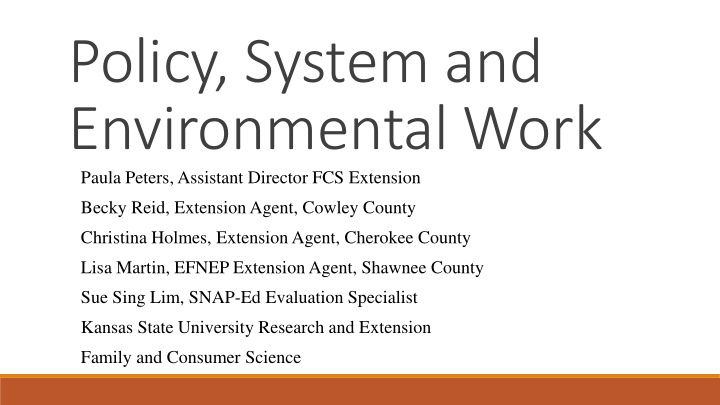



Policy, System and Environmental Work Paula Peters, Assistant Director FCS Extension Becky Reid, Extension Agent, Cowley County Christina Holmes, Extension Agent, Cherokee County Lisa Martin, EFNEP Extension Agent, Shawnee County Sue Sing Lim, SNAP-Ed Evaluation Specialist Kansas State University Research and Extension Family and Consumer Science
A SEVEN STATE RESEARCH AND EXTENSION PROJECT
Project Overview Multi-state ◦ IN, KS, MI, ND, OH, SD, WI Multi-disciplinary team ◦ Nutrition ◦ Physical activity ◦ Community development ◦ Family and youth development Funding ◦ USDA Agriculture and Food Initiative (AFRI) Grant #2011-68001-30100
Innovative Aspects 7 states collaborating Socio-Ecological Model of Childhood Overweight ◦ Rural communities ◦ Low-income families ◦ Preschool aged children Community capacity development approach (PSE)
Foundation Davison and Birch, 2001- Obesity Reviews 2, 159-171.
Individual Child’s Weight Gender Age Dietary intake Physical activity Sedentary behavior Familial susceptibility to weight gain
Family Characteristics Types of foods available in home Child feeding practices, including breastfeeding Nutritional knowledge Parent’s dietary intake Parent food preferences Parent’s weight status Excessive weight gain during pregnancy Teen pregnancy Smoking during pregnancy Parent encouragement of child activity Parent preference for activity Parent’s activity patterns Monitoring TV hours Peer and sibling interactions Child abuse
Policy, Systems and Environment Influences Ethnicity School lunch programs Work hours Leisure time Accessibility of recreational facilities Rurality Accessibility of convenience foods and restaurants Family leisure time activities School PE programs Crime rates and neighborhood safety Socioeconomic status
Situation Childhood obesity ◦ Greater risk in rural areas ◦ Greater risk in low income Obese by age 4 ◦ Increased risk of being overweight or obese as an adult
Why Focus on Environment? Growing evidence shows that environment is related to the incidence of obesity Healthy choices need to be easy choices ◦ Environmental changes can improve the health of the whole community, not just individuals
Community Coaching One community per state assigned a “Community Coach” “A Community Coach: a guide who supports communities and organizations in identifying and achieving their goals.” (Emery, Hubbell, & Miles-Polka, 2011)
Project Goals 1. To empower rural communities to create and sustain environments that support healthy lifestyles for young children, with emphasis on good nutrition and physical activity . 2. Test a community coaching model.
Approach – Methods 1 intervention, 1 comparison community per state Community coach hired and placed with intervention coalition Each community received funding ◦ Nutrition ◦ Physical activity
Community Assessments ◦ Parent survey ◦ Coalition assessed the community resources that might affect a young child’s weight ◦ Coalition self assessments
Kansas Counties Involved Cowley County ◦ Community coach Cherokee County ◦ No community coach
Insights Community Coaching is being “refined” ◦No “right” way Relationships and partnerships are essential ◦ Coalition members ◦ Coaches, staff, students Reflection is critical Sustaining community involvement over an extended time is challenging
Research Team Program Director: Paula Peters, PhD Kansas Co-Director: Sandy Procter, PhD, RD Community Partners: Becky Reid, Cowley County Christina Holmes, Cherokee County Modules: http://media.cph.ohio-state.edu/articulate/CPCOToolkit/story.html PDF version : http://media.cph.ohio-state.edu/articulate/CPCOToolkit/story.html
Communities Preventing Childhood Obesity BECKY REID, EXTENSION AGENT CHRISTINA HOLMES, EXTENSION AGENT
Community Gardens and Local Food Councils LISA MARTIN, EFNEP EXTENSION AGENT
Evaluation for PSE intervention SUE SING LIM, SNAP-ED EVALUATION SPECIALIST
There is no PSE intervention yet.
Communitycommons.org, Have you looked at data online to kic.kdheks, datacenter.kidscount.org get a whole picture of problems in your counties/districts? yes Have the Advocacy Committee survey been conducted? yes Talk to your No Is there any coalition, community members. organization or others to work with you? yes
There is planning for PSE intervention.
This is different than the advisory committee Have you and your survey. This focus on the coalition/organization discuss how to specific issue you and collect baseline data before your partners want to implementation of programs? tackle. yes Have you and your coalition/organization discuss if you want to know how well the programs run? yes Have you and your coalition/organization discuss the method to identify if your program is effective or not? yes
PSE intervention is up and running.
Is there a particular site for PSE intervention? yes Have you entered PSE information into PEARS?
Activity time!
Scenario #1 You have been doing SNAP-Ed nutrition education for young children especially in childcare centers. Now, you are unable to do only nutrition education directly with Pre-K students. You still have a deep connection with the kids, parents, and childcare providers and you believe there are needs to be addressed. What may be the problems in terms of PSE? Who are the stakeholders (people will be affected)? What are some barriers? Who or what can you ask for help? What are some evaluation questions?
Scenario #2 You have joined a coalition that is concerned with the health of Hispanics/Latinos. You and your coalition have done your part to determine problems at your communities pertaining to the goals of SNAP-Ed, such as improving identification of healthy foods, improving overall dietary quality and increasing participation in physical activity. In terms of PSE, what can you and your coalition tackle? What are some special needs in this demographic? What can you do to guide your coalition when planning PSE interventions? What are some evaluation questions?
Scenario #3 You are in the rural part of Kansas. Food access is definitely the most critical problem based on data and your own experiences. However, you and your coalition/organization/partners are unsure what to do as food access is such a broad issue. What can you and your partner do to narrow down the problem? How would you and your partners plan PSE intervention? How do you and your partners determine priorities of the problem? What are some evaluation questions?
Services Sue Sing can provide for SNAP- Ed agents and educators: Make sense of PEARS data Identify validated surveys ◦ Analyze data Provide insights on method of collecting data Site visits
Questions 0 2 / 0 7 / 2 0 1 7
Recommend
More recommend